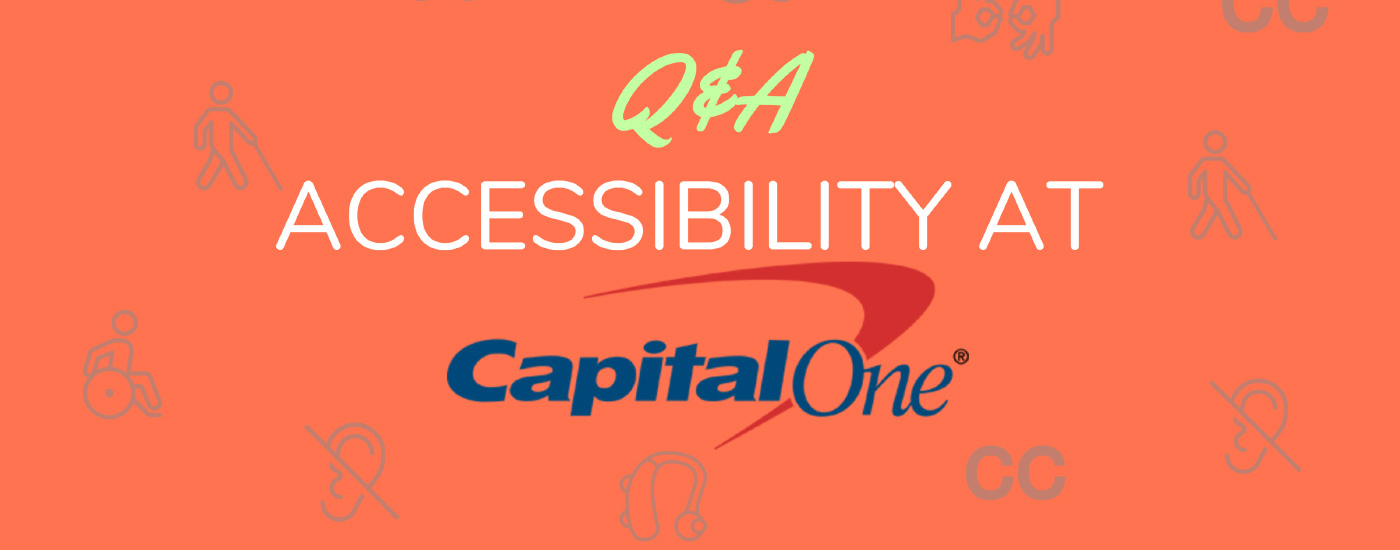Q&A: Accessibility at Capital One
Updated: February 2, 2021
Capital One is committed to making their products and services accessible to everyone, including individuals with disabilities. In fact everything at Capital One is designed with accessibility at the forefront because they know that accessibility means usability for everyone. When you’re in the business of online banking, this is a must!
In the webinar, Accessibility at Capital One, Mark Penicook provides a closeup look at Capital One’s commitment and strategies for promoting web accessibility. This Q&A provides you with some of the insight he shared into Capital One’s best practices for accessibility within the corporate space.
What’s one piece of advice you wish you’d been given so you didn’t have to learn the hard way?
MARK PENICOOK: When it comes to accessibility, do not focus your efforts on remediation. Do not spend all of your resources and time simply going out and fixing what’s already out there and broken. I’m not saying don’t do that at all, but be careful not to focus all of your resources and efforts there.
“For example, if we excel at accessibility we’re going to have a more usable interface and a more usable product for everyone.”
If you approach your accessibility program from the perspective of constantly fixing what’s broken you will end up in a perpetual vicious cycle. If you don’t move upstream, and you don’t integrate all of the new things that are being worked on, you’ll never have a sustainable accessibility program. It’s like putting your fingers in the dike of the flood – the water will continue to come. So I would say think about that and don’t focus solely on remediation.
Is your team involved with accessibility QA? If so, what tools do you use?
MARK PENICOOK: Yes, we absolutely are. We have a couple of things that we do. While there’s a tremendous amount that has to be done manually, we have a big push for automation here at Capital One. We want to leverage as much automation from accessibility testing as we can.
We work with two vendors that offer software packages, and we use both of these tools in different ways. We periodically test production for monitoring where we want to test what’s out in the real world. Then we are also testing and integrating automation throughout our pipeline before release.
What sort of assessment of products do you do? Do you do user testing in addition to expert audits?
MARK PENICOOK: We have a user labs function in Capital One. We’re up to eight or nine different labs throughout the country. My team does subject matter expert testing. We use a combination of automated tool-based testing and manual testing.
In addition, we have our user labs groups who do user testing. We work with them to include people with disabilities in those testings in many different capacities or different ways. Then I have done user testing myself with our customers who have disabilities as well.
“They created the accessibility team because they valued it and they knew it was important.”
You talked about a high level of senior/executive commitment. How did the internal team initially generate this, and how have they maintained such support?
MARK PENICOOK: Fortunately our senior leadership, going back to the beginning of the accessibility team here at Capital One, recognized the importance of accessibility. They created the accessibility team because they valued it and they knew it was important. At that point, we were not driven by any kind of legal, reputational, regulatory, or compliance concerns to address accessibility. We were lucky to have a starting point like that, and we’re also lucky that the senior leader of the organization values accessibility and is highly aware of it. Beyond that, we’ve done a few things to create buy-in and generate awareness.
- The first thing is to show how what is being done for accessibility is also best practice. For example, if we excel at accessibility we’re going to have a more usable interface and a more usable product for everyone. That’s market share, and it makes a better end result.
- Secondly, most organizations today – when it comes to tech – are thinking about the future. They’re thinking about augmented reality. They’re thinking about the internet of things and all these different applications. We make the push for accessibility being something that would allow all that to work better. For example, it would ensure that your codebase is semantically correct more so than what it may be at the present time. It ensures that assistive technologies and other devices are going to be able to consume your application and use it more seamlessly. That’s something that gets a lot of attention.
- Lastly, we started enterprise reporting on where we can improve on accessibility. It makes it come close to home because we own this delivery pipeline. If the things that are coming off of it aren’t built as well as we want them to be, we can hold ourselves accountable for that.
So those are kind of the three main drivers for how we’ve been able to get that by and to get that senior executive support.
__
Be sure to watch the full webinar!
Further Reading

Subscribe to the Blog Digest
Sign up to receive our blog digest and other information on this topic. You can unsubscribe anytime.
By subscribing you agree to our privacy policy.





